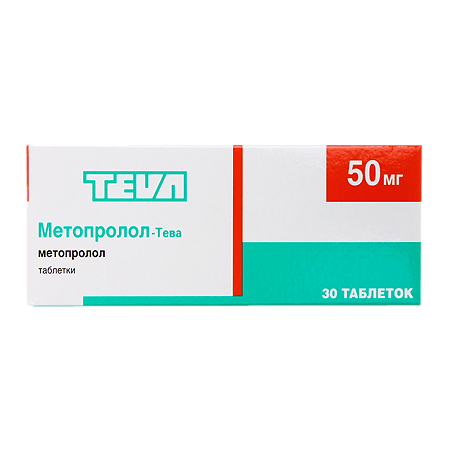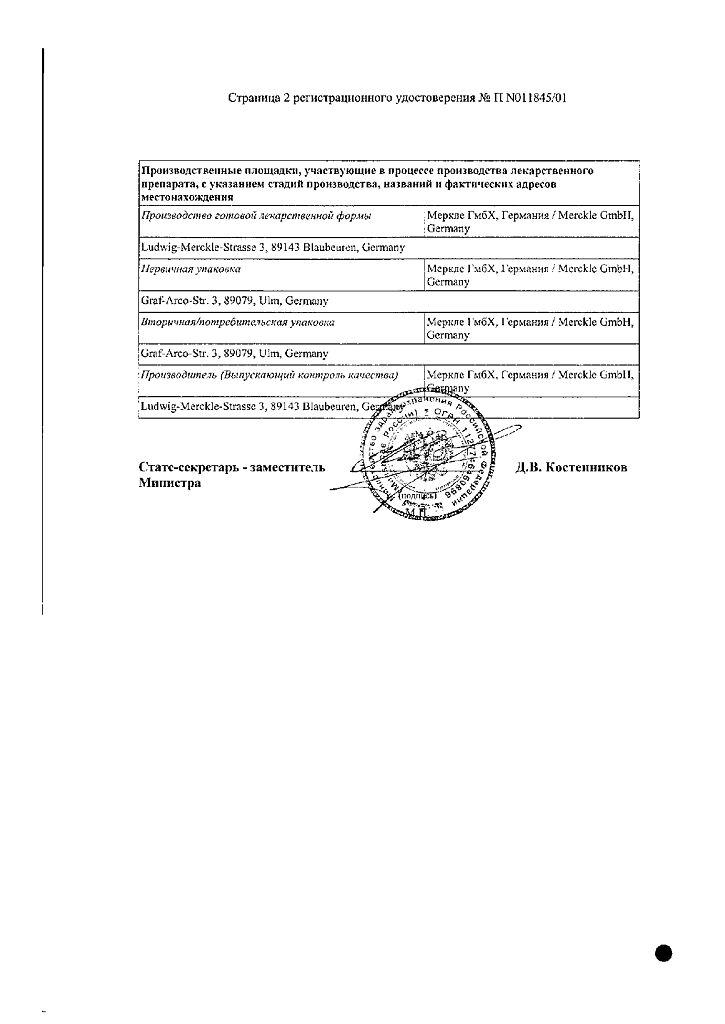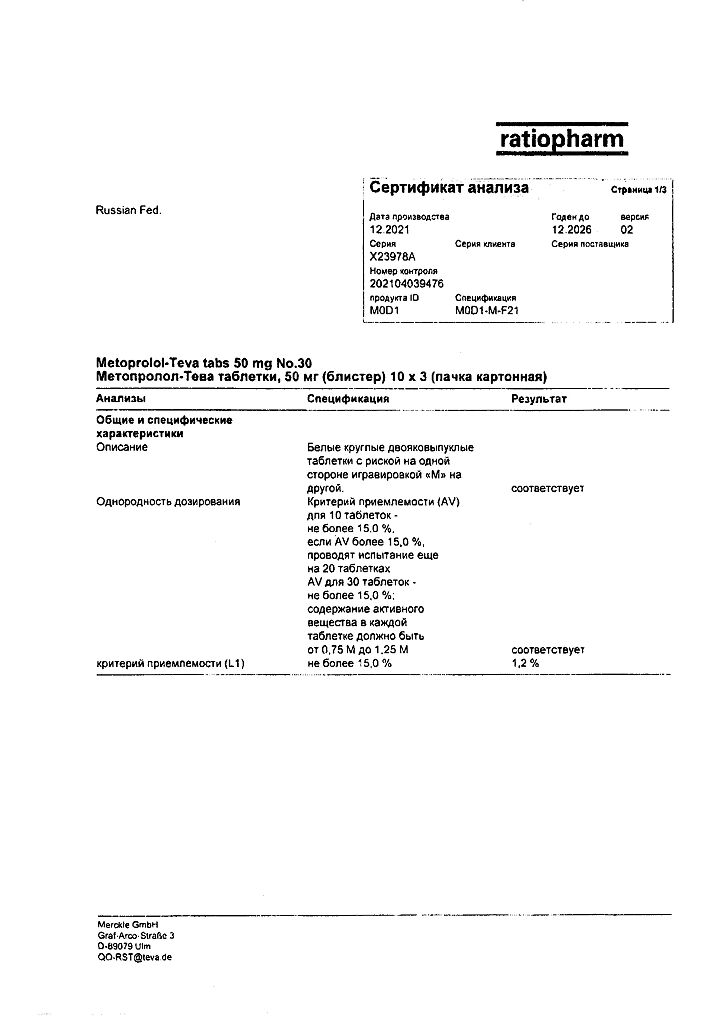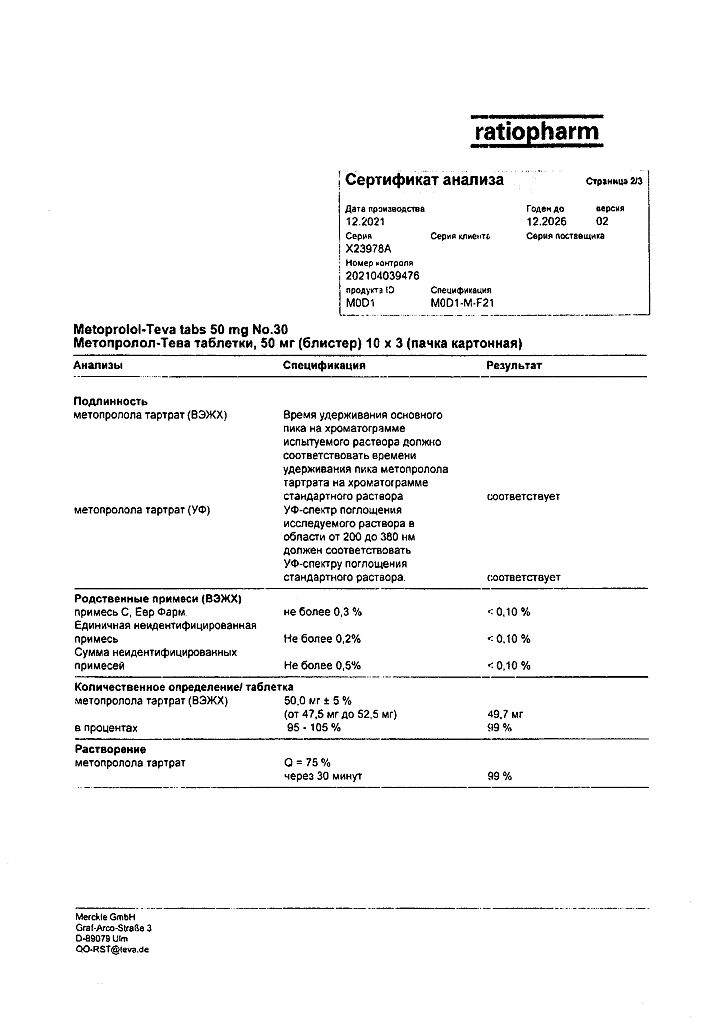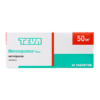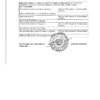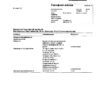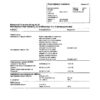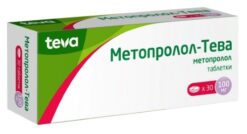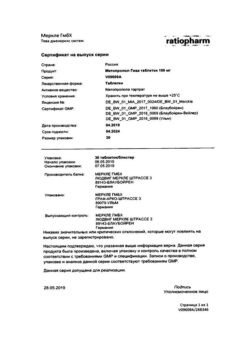No products in the cart.
Metoprolol-Teva, tablets 50 mg 30 pcs
€3.00 €2.80
Description
METOPROLOL is a selective beta-adrenoblocker, acting predominantly on the beta 1 -adrenoreceptors of the heart (“cardioselective beta-adrenoblocker”) without intrinsic sympathomimetic activity and with a weak membrane stabilizing effect. It has antianginal, hypotensive and antiarrhythmic effects.
Blocking in low doses beta 1-adrenoceptors of heart, it decreases catecholamine-stimulated cAMP formation from ATP, decreases intracellular calcium ions flux, produces negative chrono-, dromo-, batmo- and inotropic action (decreases heart rate, inhibits conduction and excitability and decreases myocardial contractility).
The total peripheral vascular resistance at the beginning of administration of beta-adrenoblockers (in the first 24 hours after oral administration) increases (as a result of reciprocal increase of activity of alpha-adrenoreceptors and elimination of stimulation of beta 1-adrenoreceptors) which returns to baseline in 1-3 days and decreases with long-term administration.
Hypotensive effect is caused by decrease of cardiac output and renin synthesis, inhibition of renin-angiotensin system activity (important in patients with initial renin hypersecretion) and central nervous system, restoration of aortic arch baroreceptors sensitivity (their activity in response to blood pressure decrease is not increased) and finally, reduction of peripheral sympathetic effects. Reduces elevated blood pressure (BP) at rest, during physical exertion and stress.
The hypotensive effect is rapid (systolic BP decreases in 15 minutes, maximum in 2 hours) and lasts for 6 hours, diastolic BP changes slower: a stable decrease is observed after several weeks of regular use.
The antianginal effect is determined by decreasing myocardial oxygen demand as a result of decreasing HR (prolongation of diastole and improvement of myocardial perfusion) and contractility and decreasing myocardial sensitivity to sympathetic innervation. It reduces the number and severity of angina attacks and increases exercise tolerance.
Antiarrhythmic effect is caused by the removal of arrhythmogenic factors (tachycardia, increased activity of the sympathetic nervous system, increased content of CAMF, arterial hypertension), reduction of the rate of spontaneous excitation of sinus and ectopic pacemakers and slowing of atrioventricular conduction (mainly in antegrade and, to a lesser extent, in retrograde direction through the atrioventricular (AV) node) and through additional pathways.
In supraventricular tachycardia, atrial fibrillation, sinus tachycardia, in functional heart disease and hyperthyroidism, it reduces HR or may even lead to restoration of sinus rhythm. Prevents the development of migraine. When used in medium therapeutic doses, unlike non-selective beta-adrenoblockers, it has less pronounced effect on the organs containing beta 1 -adrenoreceptors (pancreas, skeletal muscles, smooth muscle of peripheral arteries of bronchi and uterus) and on carbohydrate exchange. When used in high doses (more than 100 mg/day) it has a blocking effect on both beta-adrenoreceptor subtypes.
Indications
Indications
Active ingredient
Active ingredient
Composition
Composition
1 tablet contains:
metoprolol tartrate 50 mg.
Auxiliary substances:
Microcrystalline cellulose,
Corn starch,
Croscarmellose sodium,
copovidone,
colloidal anhydrous silica,
Magnesium stearate.
How to take, the dosage
How to take, the dosage
The tablets are taken orally with a small amount of liquid, without chewing, with food or immediately after a meal. The tablets can be divided. The course of treatment is not limited in time and depends on the course of the disease. If it is necessary to cancel the treatment, the dose is reduced gradually (at least 10 days) under medical supervision.
Arterial hypertension – the initial daily dose is 50-100 mg in 1-2 doses (morning and evening). In case of insufficient therapeutic effect, the daily dose may be gradually increased to 100-200 mg. The maximum daily dose is 200 mg.
Stenocardia, arrhythmias, prevention of migraine attacks – 100-200 mg per day in two doses (morning and evening).
Secondary prevention of myocardial infarction – 200 mg per day in two doses (morning and evening).
Functional disorders of cardiac activity accompanied by tachycardia – 100 mg per day in two doses (morning and evening).
When therapeutic effect is achieved, the dose is reduced (under medical supervision). For elderly patients, it is recommended to start treatment with 50 mg/day.
Interaction
Interaction
Combined use with monoamine oxidase inhibitors (MAOIs) is not recommended due to a significant increase in the hypotensive effect. A treatment interval between MAO inhibitors and metoprolol should be at least 14 days.
Concomitant intravenous administration of verapamil may induce cardiac arrest. Simultaneous administration of nifedipine leads to a significant decrease in BP.
The agents for inhalation anesthesia (hydrocarbon derivatives) increase the risk of myocardial depression and arterial hypotension.
Beta-adrenergic stimulants, theophylline, cocaine, estrogens (sodium retention), indomethacin and other non-steroidal anti-inflammatory drugs (sodium retention and blocking of prostaglandin synthesis by the kidneys) weaken the hypotensive effect.
There is marked an increased suppressive effect on the central nervous system – with ethanol; summation of the cardiodepressant effect – with anesthetics; increased risk of peripheral circulatory disorders – with ergot alkaloids.
When co-administered with oral hypoglycemic agents, their effect may be decreased; with insulin – increased risk of hypoglycemia, its increased severity and prolongation, masking of some symptoms of hypoglycemia (tachycardia, sweating, increased BP).
When combined with hypotensive agents, diuretics, nitroglycerin or slow calcium channel blockers, a sharp decrease in BP may develop (special caution is necessary when combined with prazosin ); increased severity of HR slowing and suppression of atrioventricular conduction when using metoprolol with verapamil, diltiazem, antiarrhythmic agents (amiodarone), reserpine, clonidine, guanfacine, agents for general anesthesia and cardiac glycosides.
Hepatic microsomal enzyme inducers (rifampicin, barbiturates) lead to increased metabolism of metoprolol and decreased plasma concentrations of metoprolol and reduced effect.
Inhibitors (cimetidine, oral contraceptives, phenothiazines) – increase plasma concentrations.
Allergens used for immunotherapy or allergen extracts for skin tests when combined with metoprolol increase the risk of systemic allergic reactions or anaphylaxis; iodine containing X-ray contrast agents for IV administration increase the risk of anaphylactic reactions.
Decreases clearance of xanthine (except diphylline), especially in patients with initially increased clearance of theophylline due to smoking. Reduces lidocaine clearance, increases plasma lidocaine concentrations. Increases and prolongs the effect of antidepolarizing myorelaxants; prolongs the anticoagulant effect of coumarins.
In co-administration with ethanol the risk of significant BP decrease increases.
Special Instructions
Special Instructions
The monitoring of patients taking beta-adrenoblockers includes regular monitoring of HR and BP, blood glucose content in diabetic patients (once every 4-5 months).
If necessary for diabetic patients, the dose of insulin or oral hypoglycemic agents should be adjusted individually.
The patient should be taught how to calculate heart rate and instructed to consult a physician if the heart rate is less than 50 bpm.
If doses above 200 mg per day are taken, cardioselectivity decreases.
In heart failure, treatment with metoprolol is not started until the compensation stage is reached. It is possible to increase the severity of hypersensitivity reactions (against a strong allergic history) and the lack of effect of administering the usual doses of epinephrine (adrenaline). It may aggravate the symptoms of peripheral arterial circulatory disorders.
The drug is withdrawn gradually, reducing the dose over 10 days. If treatment is stopped abruptly, a “withdrawal” syndrome may occur (increased angina pectoris attacks, increased BP). Special attention should be given to patients with angina pectoris when withdrawing the drug.
In angina patients with tension angina, the selected dose of the drug should provide an HR at rest within 55-60 beats/min, and not more than 110 beats/min on exertion.
Patients who wear contact lenses should be aware that treatment with beta-adrenoblockers may decrease lacrimal fluid production.
Methoprolol may mask some clinical manifestations of thyrotoxicosis (e.g., tachycardia). Abrupt withdrawal in patients with thyrotoxicosis is contraindicated because it may exacerbate the symptoms.
In diabetic patients may mask tachycardia caused by hypoglycemia. Unlike non-selective beta-adrenoblockers, it practically does not increase insulin-induced hypoglycemia and does not delay the recovery of blood glucose concentration to normal levels.
In patients with bronchial asthma, beta 2-adrenoceptors are used as concomitant therapy; in pheochromocytoma, alpha-adrenoblockers are used.
If it is necessary to perform surgery, the anesthesiologist must be warned about the therapy (choice of general anesthesia agent with minimal negative inotropic effect); cancellation of the drug is not recommended.
Drugs that decrease catecholamine stores (e.g., reserpine) may increase the effects of beta-adrenoblockers, so patients taking these combinations of drugs should be under constant medical monitoring for excessive BP and bradycardia.
Patients with depressive disorders taking metoprolol should be monitored closely; if depression develops in response to beta-adrenoblocker therapy, therapy should be discontinued.
Wear appropriate clothing when treating with metoprolol, as the drug may cause allergic skin to sunlight.
In elderly patients, monitoring of liver function is recommended. The dosing regimen should be adjusted only in elderly patients with increasing bradycardia (less than 50 beats/min), marked BP decrease (systolic BP below 100 mmHg), atrioventricular block, bronchospasm, ventricular arrhythmias, severe liver function abnormalities; sometimes the treatment must be stopped.
In the absence of sufficient clinical data, the drug is not recommended for use in children.
At the time of treatment it is necessary to refrain from driving motor transport and engaging in potentially hazardous activities requiring increased concentration and rapid psychomotor reactions, avoid taking ethanol.
Contraindications
Contraindications
Particular caution:
In all of the above cases, the treating physician should carefully weigh the benefit/risk ratio when prescribing the drug.
Side effects
Side effects
Nervous system disorders: increased fatigue, weakness, headache, slowed rate of mental and motor reactions; rarely – paresthesias in the extremities (in patients with claudication and Raynaud’s syndrome), depression, anxiety, reduced attention, drowsiness, insomnia, nightmares, confusion or short-term memory loss, muscle weakness.
Sensory organs: rarely – decreased vision, decreased tear fluid secretion, dry and sore eyes, conjunctivitis, tinnitus.
Cardiovascular system disorders: sinus bradycardia, palpitations, decreased BP, orthostatic hypotension, dizziness, sometimes loss of consciousness); rarely – decreased myocardial contractility, temporary worsening of symptoms of chronic heart failure (edema, swelling of the feet and/or lower legs, dyspnea), arrhythmias, angiospasm (increased peripheral circulatory disorders, coldness of the lower extremities, Raynaud’s syndrome), myocardial conduction disorders, cardialgia.
Digestive system disorders: nausea, vomiting, abdominal pain, dry mouth, diarrhea, constipation, liver function disorders, change in taste.
Skin disorders: urticaria, skin itching, rash, exacerbation of psoriasis, psoriasis-like skin reactions, skin hyperemia, exanthema, photodermatosis, increased sweating, reversible alopecia.
Respiratory system: nasal congestion, difficulty in exhaling (bronchospasm when prescribed in high doses – loss of selectivity and/or in predisposed patients), dyspnea.
Endocrine system: hypoglycemia (in patients receiving insulin), rarely: hyperglycemia (in patients with diabetes), hypothyroidism.
Laboratory parameters: rare: thrombocytopenia (unusual bleeding and hemorrhage), agranulocytosis, leukopenia, increased activity of liver enzymes; extremely rare: hyperbilirubinemia.
Fetal effects: possible intrauterine growth retardation, hypoglycemia, bradycardia.
Others: back or joint pain, as all beta-adrenoblockers in single cases may cause a slight increase in body weight, decreased libido and/or potency.
Overdose
Overdose
Symptoms: severe sinus bradycardia, dizziness, nausea, vomiting, cyanosis, marked BP decrease, arrhythmia, ventricular extrasystole, bronchospasm, syncope, in acute overdose – cardiogenic shock, loss of consciousness, coma, atrioventricular block (up to development of complete transverse block and cardiac arrest), cardialgia. The first signs of overdose appear 20 minutes to 2 hours after taking the drug.
Treatment: gastric lavage, prescription of adsorptive agents, symptomatic therapy: if BP is significantly decreased – the patient should be in Trendelenburg position; in case of excessive pressure drop, bradycardia and cardiac insufficiency – intravenous drugs with 2-5 min intervals, bat-adrenostimulants – until desired effect is achieved, or intravenous 0.5-2 mg of atropine sulfate. If there is no positive effect, dopamine, dobutamine or norepinephrine (noradrenaline). As a follow-up, prescription of 1-10 mg of glucagon, placement of transvenous intracardiac pacemaker is possible. In bronchospasm, IV beta 1 -adrenoreceptor stimulants should be administered. Slow IV administration of diazepam in case of seizures. Hemodialysis is not effective.
Pregnancy use
Pregnancy use
In pregnancy (especially in the first 3 months), the drug should be used only under strict indications, with careful weighing of the benefit/risk ratio, since there is still insufficient experience with its use in pregnancy, especially in early pregnancy.
If pregnant women have taken metoprolol, due to the possibility of bradycardia, arterial hypotension, and hyperglycemia in the newborn, treatment should be stopped 48-72 hours before delivery. If this is not possible, the newborn should be monitored particularly closely for 48-72 hours after delivery.
The effect of metoprolol on the newborn, while breastfeeding has not been studied, so women taking the drug should stop breastfeeding.
Similarities
Similarities
Additional information
| Shelf life | 5 years. |
|---|---|
| Conditions of storage | Store at temperatures not exceeding 30 ° C. Keep out of reach of children. |
| Manufacturer | Merkle GmbH, Germany |
| Medication form | pills |
| Brand | Merkle GmbH |
Other forms…
Related products
Buy Metoprolol-Teva, tablets 50 mg 30 pcs with delivery to USA, UK, Europe and over 120 other countries.

